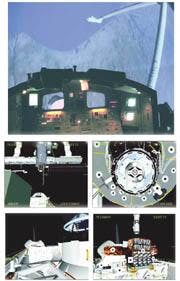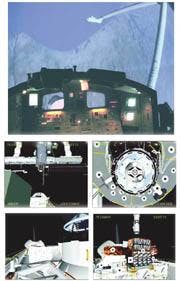By John McHale
HOUSTON — Engineers at Lockheed Martin Space Operations Co. in Houston needed a scan converter to improve the viewable image of the simulations they were designing in the Systems Engineering Simulator (SES) laboratory at NASA's Johnson Space Center, so they chose the RGB/VideoLink 1690 from RGB Spectrum in Alameda, Calif.
"The VideoLink 1690 scan converters look great," says Regina Tobias, electronics engineer for the Lockheed Martin Science, Engineering, Analysis, and Test (SEAT) division's Space Operations Co. "They enable the SES simulators to provide the most realistic, flight-like mission scenarios."
A close market survey of scan converters led to the RGB choice, Tobias says. "Lockheed Martin's Space Operations Company conducted extensive market evaluations of different scan converter brands and models for the project," she says. "RGB Spectrum's RGB/VideoLink 1690 was chosen because it was the only scan converter that improved the viewable image with exceptional clarity and precise detail."
The SES mission will provide a dynamically correct, high-fidelity, Space Shuttle crew-in-the-loop simulator to support critical flight decisions before and during mission operations.
"The SES was expanded over the years to include space-station activities," Tobias says. The activities
around the station, such as vehicles flying to and from the station, manipulation of payloads around the station, and satellite servicing, are extremely dependent on manned interaction and require much simulation to determine the safest mode of operation.
The SES supports Space Shuttle and Space Station crew training for the Shuttle Remote Manipulator System (RMS), the Space Station RMS, and rendezvous/proximity operations.
"The overall program complex consists of the real-time operator-in-the-loop Spacecraft Dynamics Simulation (SCDS), three Dynamic System Trainers (DSTs), and the ascent/entry Shuttle Engineering Simulator," Tobias explains. "The SCDS simulation provides accurate real-time dynamics and pilot environment models designed for as many as six free-flying vehicles with six-degree-of-freedom equations of motion for each vehicle and for the interactions between them. These interactions can include docking contact dynamics involving berthing and unberthing of vehicles, aerodynamics, thruster plume impingement, vehicle control systems, and robotics manipulator dynamics."
Conversion and distribution
A critical issue in the simulator was the conversion and distribution of high-resolution images from the SCDS image generators to the aft station CCTV CRTs, Tobias says. "Since the simulation exercises rely heavily on visual cues and overlays as pilots maneuver with the docking target, the converted images had to be very high quality, with sharp, fine graphics."
NASA currently uses eight RGB/VideoLink 1690 scan converters in the simulators' two aft cockpit stations and Robotic Workstations (RWS), RGB officials say. These aft stations are for docking and robot arm control. The scan converters receive 1,280-by-1,024-pixel RGB images from Pentium 4–based PCs and SGI Onyx2 image generators.
The images consist of high-resolution graphical reproductions of the space-shuttle vehicle, the shuttle robot arm, the space station, and terrestrial and space out-the-window (panoramas. Navigation and guidance parameters, flight trajectories, and cross hairs also overlay on appropriate images to facilitate maneuvering and alignment.
The 1690s convert the images to NTSC composite signals and feed them to each of the aft stations' two Sony 9-inch high-resolution CCTV monitors, which are mounted near the two windows in the shuttle exterior, RGB officials say. The two rear windows in the shuttle depict faithful, realistic out-the-window vistas that would be viewed by shuttle crew in-flight. The CCTVs provide the crew with detailed, selectable video images of camera views of activity or objects outside the shuttle.
The RGB/Videolink 1690 video scan converter transforms computer signals to broadcast standard video in real time. The simulator can record, broadcast, or display computer-generated images, or transmit them over video codecs. The unit offers NTSC/PAL composite video, S-Video and component analog video (Betacam/MII) outputs. SMPTE 259M digital output is available as an option. State-of-the-art digital signal-processing circuitry eliminates interlace flicker in the output image.
The 1690's zoom function enables users to scale a portion of the image to fill the video screen or provide just the right amount of underscan/overscan adjustment, company officials say. Synchronization and set-up are automatic. The RGB/Videolink 1690 automatically synchronizes to computer signals up to 1600 by 1200 pixels, including virtually all desktop computers and workstations.
For more information on the RGB/VideoLink 1690 contact RGB Spectrum online at www.rgb.com.




